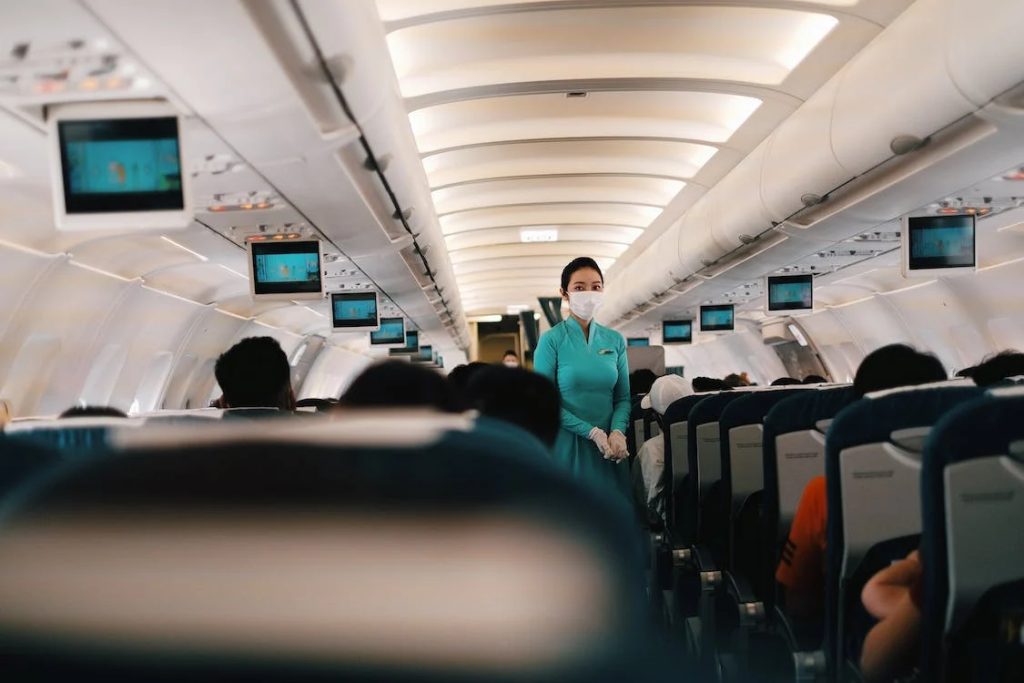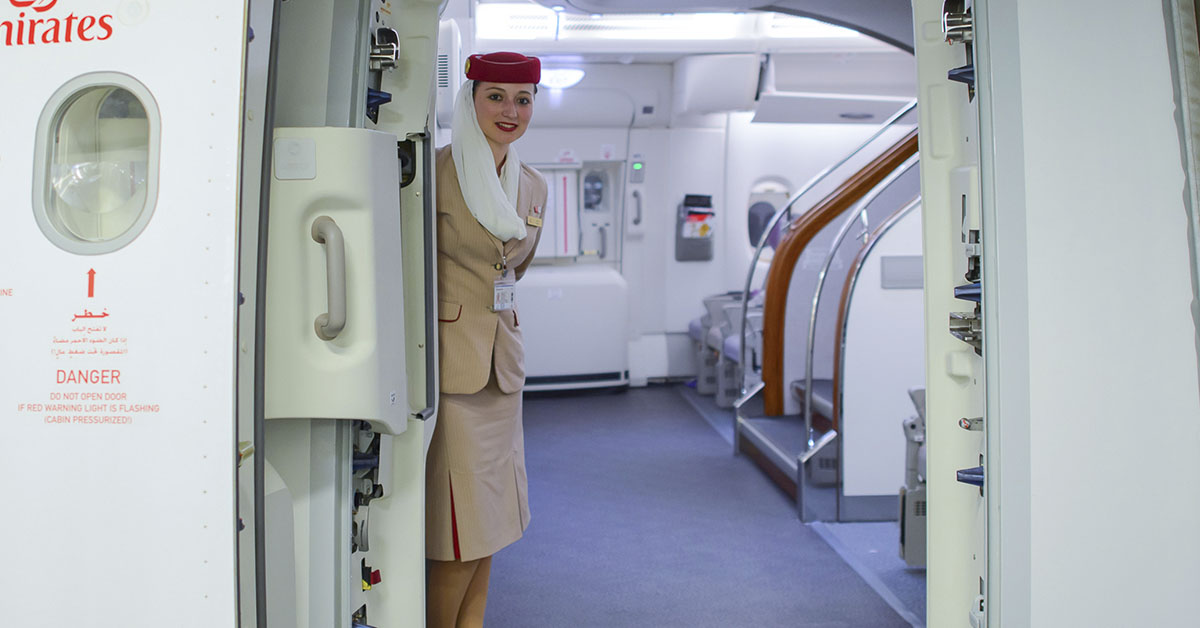Imagine, if you will, that you’re on the verge of leaving on the vacation you’ve always dreamed of, and your mode of transportation is an airplane. Envision yourself joyfully stepping onto the aircraft, warmly welcomed by a friendly and accommodating cabin crew. Now, consider this. Where exactly are the flight attendant’s arms?
We understand that this may appear to be an unusual query. Typically, when you’ve flown in the past, your focus was likely directed towards the faces of the cabin crew, as well as the delightful beverages and snacks they provided. If you’ve ever taken notice of their arms and hands, it was likely during the safety demonstration. (Which, we hope, got your attention!).
However, if you observe them more closely on other occasions, you may notice something slightly odd. Their arms are often posted behind their backs.
This unique posture is not limited to the boarding process alone. At the start of the flight, you may also observe cabin crew members making their way down the aisles with their arms diligently posted behind their backs. Considering that this walking position does not appear natural or comfortable, it piques our curiosity about why it is being adopted.
Adding to the intrigue is the fact that not all flight attendants adopt this posture. If you reflect on your boarding experience, you will recall a few things. Numerous crew members use their hands to assist passengers, open and close overhead bin space, and carry out pre-flight preparations. Therefore, the hands-behind-the-back stance cannot be solely attributed to matters of decency, germaphobia, displaying a calm and friendly demeanor, or similar reasons.
So, is our speculation over the top? Not at all! As it turns out, the flight attendant stationed at the front or patrolling the aisles with their hands behind their back is performing a specific and very important task: counting.
Yes, counting. More specifically, they are responsible for tallying the passengers on the plane to ensure that the number of individuals entering the aircraft matches the figures documented for the flight. To aid in this endeavor, the designated flight attendant typically wields a manual clicker counter. Allowing for a more accurate count of passengers. Which can range from as few as 100 on regional flights to over 600 on Airbus airliners.

As for the cabin crew walking up and down the aisles?
Indeed, the counting performed by flight attendants serves as a secondary check once all passengers have taken their seats. Thus ensuring that the number of individuals who checked in and passed through the boarding gate with a valid boarding pass aligns with the actual number of passengers on the aircraft.
Furthermore, counting can also aid in determining the weight the plane is carrying. This helps the crew assess whether cargo or, in the case of smaller planes, even passengers need to be rearranged to ensure a safe flight. Additionally, in situations where airlines have overbooked flights, the count assists in determining how many individuals from the standby list can be accommodated for boarding.
The rationale behind the hands-behind-the-back position appears to stem from a desire among crew members to avoid drawing excessive attention to themselves or their tasks. While practices may vary between airlines and individuals, the general consensus suggests that keeping their hands and counting clickers discreetly positioned behind their backs makes the process less conspicuous to everyone on board.
Read: Flight Attendant Won’t Let Plane Leave Until Passengers Clean Up Mess Dropped In The Aisle
So now that we have those answers, we ask the cabin crew a few more questions
Do deceased passengers remain in their seat for the duration of the flight?
“Yes. Thankfully I’ve never been in that situation, and I don’t know anyone who has been in that situation.” They said. “I would probably put a blanket over the person so it would become less of something to look at. You want to maintain dignity and respect for someone who passed away. You don’t want anyone staring at them. That would be really sad.”
What happens in the event that a passenger point blank refuses to wear their seatbelt when instructed to do so?
“When a seatbelt sign is on but it’s smooth, some people don’t listen. They want to go to the bathroom — they don’t want to be rude and ugly — but they want to go to the bathroom, so they get up to go to the bathroom.” Additionally, “Well, I’m not going to physically force you to stop. I’m not going to tell you ‘No, you can’t go to the bathroom.’ I’m just going to inform you because I’m required to inform you, that the captain still has his seatbelt sign on, and I don’t think it’s safe for you to be up. And then they usually say, ‘Well, I just have to pee.’
“OK, well, I don’t want to be involved in that decision — you’re the adult, you make that decision.” And “If the flight attendants are sitting down with their seat belts on, it’s probably a good idea to have yours on too.” They continued: “Am I going to get crazy over seat belts? No. Am I going to be concerned about somebody that’s not listening to any instructions and is not acting appropriately? Yes.”

Cabin crew members go on to describe even more scenarios for us
What sort of behavior will see a passenger kicked off a flight by the cabin crew?
“If you were to come on the plane drunk, you’d be escorted off the plane. Because we don’t need you to get up to 35,000 feet and get crazy on us. Most of the time people don’t do that. But, as a flight attendant, you have to do things with an abundance of caution.”
“If you got physical, depending on what the act was, we might divert the plane. But I don’t make those decisions. I convey the information to the cockpit and the chief flight attendant, and they make the decision about whether or not we’re going to land and get someone off the plane.“
“If you try to open a door mid-flight, that’s happened a couple of times.” Additionally, “If you were belligerent with us before we took off, you wouldn’t go. Most of the pilots say to us, ‘If you’ve got a problem with them, I’ve got a problem with them,’ and they will back us up 100%.”
“We all just want to get on the plane and get where we’re going. We don’t need to have any problems. It’s the law that you comply with the crew members’ instructions. My job isn’t to enforce stuff — it’s to let you know but there are certain things that you can’t cross the line on — so don’t make me pull this plane over.”
“It’s not our nature to want to fight with you. Our nature is to diffuse the situation and make everything better. Flight attendants should be able to insert a little sweetness, and confidence, and sometimes be the cop a little bit. But I’m not going to get into a fight with you. I’m going to report it, and we’re not going to make it worse than it is.“
Read: Flight Attendant Explains Why You Shouldn’t Wear Shorts On A Plane
What is the strangest encounter you have had on a plane?
“My flying has been so generic if you will. I’ve had incidents. I’ve seen a guy fall — he passed out — and his face was what broke the fall against the wall of the airplane. He did not even put his arms out. But that’s not even that strange.
“I haven’t seen this, but I did have flight attendants tell me about blood dripping from the overhead because someone was bringing in a goat’s head from a Caribbean island. That was before TSA and all their security procedures were put in place, of course.” Another commented: “For me, the strangest stuff is just gross human behavior.”
Do passengers try to grab better seats on flights?
“It happens a lot. We have two classes in economy — there are the seats that have more legroom and the seats that have less legroom — and people a lot of times will try to move up forward of the exit row. And we have to charge for that. Otherwise, I have to move you. It’s what I’m required to do.“
Name an airline rule that many passengers may have no idea exists
“According to my training, the emergency exit shades have to be up because flight attendants are required to assess the conditions outside before they open the door. If there’s fire, deep water, or rocks outside that exit, that would make it unsafe for us to go through there, and the flight attendant would have to make that determination fairly quickly.
Keep Reading: Flight Attendant Warns Why You Should Never Wear Flip Flops Or Crocs On A Plane
Sources
- “HAND-Y TO KNOW This is why flight attendants put their hands behind their backs when greeting passengers.” The Sun UK. Sarah Barns. November 6, 2016
- “A flight attendant answers the 20 questions you’ve always wanted to ask.” Insider. Rachel Gillet. May 28, 2016

